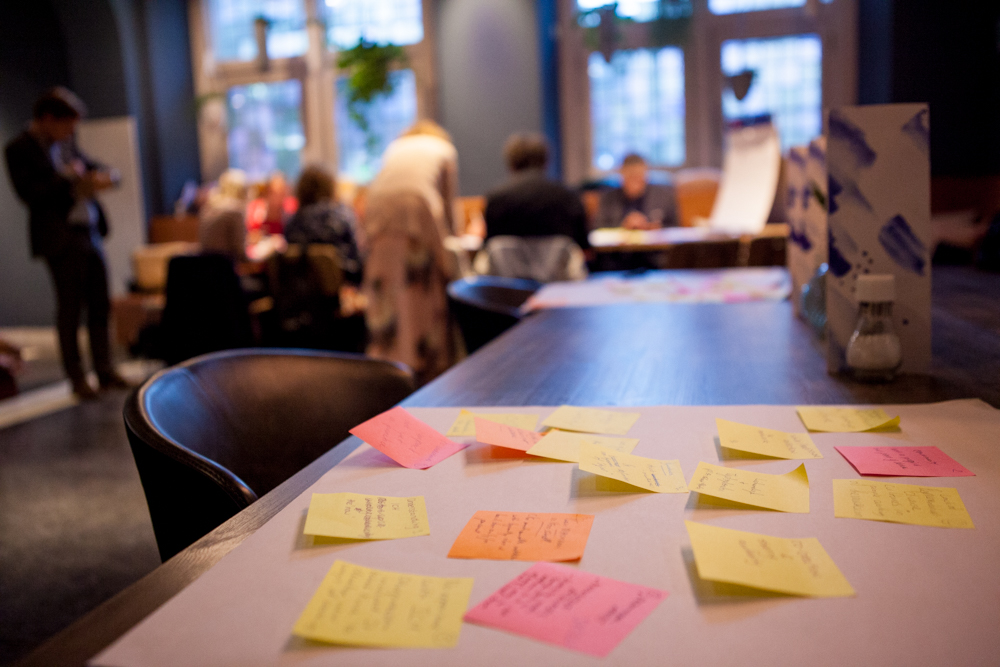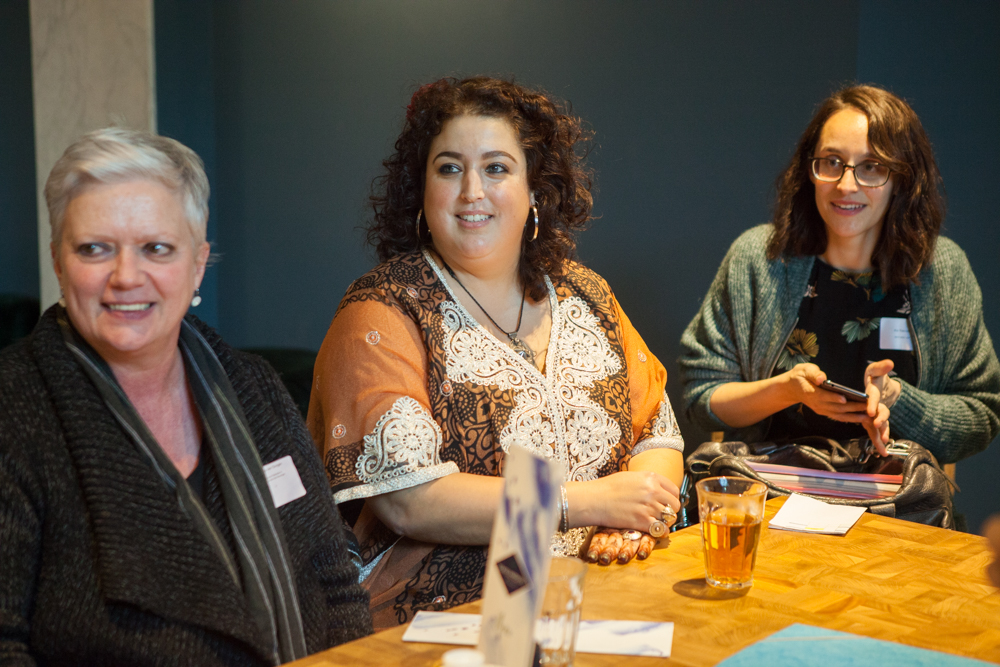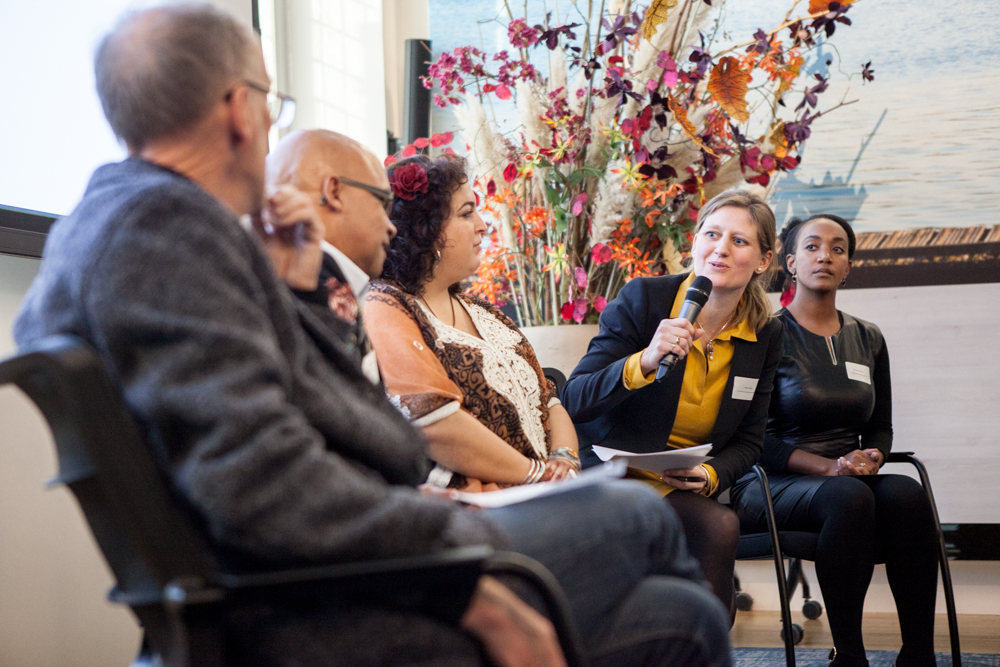Report of the International Conference: Museums, Diversity and Intangible Cultural Heritage (7.11.2017, Rotterdam)
Welcome & introduction
Leo Adriaanse, head at the Dutch Centre for Intangible Cultural Heritage, welcomed the participants of the International conference: a mix of Dutch museum professionals and a group of around twenty museum professionals from Italy, France, The Netherlands, Switzerland and Belgium that were also invited to attend the Expert meeting on November 8 (you can read the report of the Expert meeting here).
Jorijn Neyrinck (Werkplaats immaterieel erfgoed) continued with a brief introduction on the Intangible Cultural Heritage and Museums Project (IMP), to which this International conference connects. IMP wants to explore the variety of approaches, interactions and practices on intangible cultural heritage in museums and investigate how museums can play a role in the safeguarding of these living heritage practices, by working together with its practitioners in this process (read more about IMP in the ‘about-section’). IMP does this by inviting people from throughout its five partner countries (The Netherlands, Belgium, Italy, France and Switzerland), to share their experiences, successes as well as the obstacles they have encountered.
Keynote on ICH, museums and diversity
Dr. Marilena Alivizatou (University College London) gave a keynote on how the ‘museums and intangible heritage discourse’ has evolved over the last decade. After an introduction to the main principles of the UNESCO 2003 Convention, she discussed the shift from a protectionist discourse toward a discourse of ‘safeguarding’ (among others recognizing change and renewal as fundamental characteristics of this type of heritage), and stressed the need to involve the collaboration of multiple stakeholders and local communities in this process. Alivizatou sees safeguarding at the heart of contemporary museum practice, and not as a separate activity, when she aligns ICH safeguarding activities (identification, research and documentation, promotion and enhancement, …) next to core museum activities (acquisition, curation and research, exhibitions, …). According to Alivizatou, safeguarding intangible cultural heritage in museums requires furthermore a people-centred and participatory museology:
- Working with the bearers of intangible heritage to safeguard and present cultural knowledge and traditions in a contemporary context
- Expanding the scope of museum collecting
- Rethinking meanings of collections (tangible and intangible)
- Using new technologies to safeguard and represent living / intangible culture
- Create spaces for the performance of intangible heritage
- Focus on cultural revival and renewal rather than archival documentation
Keynote on superdiversity
Dr. Dirk Geldof (University of Antwerp, Faculty of Design Sciences, Karel de Grote University College Antwerp, HIG - Odisee University College Brussels) continued with sharpening the participants’ conception of superdiversity and unravelled some of the challenges relating to intangible heritage and museums.
Superdiversity is not a synonym for (ethnic) ‘diversity’ or the ‘multicultural’ society, but a new period in migration, and a profound demographic and social transition, in which the notion of majority versus minority cultures is no longer relevant. Superdiversity is also a quantitative transition, in which the diversity within the diversity increases (more nationalities, more different languages, more diversity in legal statuses, socio-economic positions, more diversity in and between different communities, …). Next to this, superdiversity is also a (contested) process of the normalisation of diversity.
Superdiversity is a reality as well as a challenge in the 21st century: societies are changing faster than ways of thinking, analysing or governing and we need new frameworks for, among others, research and policy. Moving beyond ‘us versus them’ discourses is another prime challenge.
The 21st century will become even more diverse than it is now, which means there is an urgent need for interculturalisation (i.e. that all aspects of society, like education, service and health care and communication, should be more aware of the multiple identities and cultures between people and make that the starting point of the work they do). And also for developing empowering and divers-sensitive ways of thinking, in the cultural sectors and within the UNESCO as well. Museums (and other cultural organisations) should move away from giving ‘some special attention’ to diversity, towards being organisations where superdiversity is part of the core of the organisation and its policies, according to Geldof. (Heritage) organisations should move beyond static and essentialising (or essentialistic) approaches of culture, and should approach (intangible) culture as dynamic, emphasising superdiversity, hybridity, mixity more strongly. Geldof pleas for more attention to co-creation, including dialogue and debate, within intercultural teams.
See PPT - Watch video (on demand only via info@ICHandmuseums.eu)
Inspiring museum examples on intangible cultural heritage
Following these two keynotes, that acted as the framework for the rest of the International conference, five museum professionals were invited to elaborate on their own experiences on approaching diversity in society through intangible cultural heritage in their museum practice. The session was chaired by dr. Hendrik Henrichs (University of Utrecht - NL).
- Nicole van Dijk from Museum Rotterdam (NL) talked about The Active Collection of the city: a new way of collecting for museums. Building a collection in the city by adopting objects, persons and developments in the city which are important because they connect communities or persons in the city today. See PPT - Watch video
- The permanent exhibition 100 x Aarau at the City museum of Aarau (CH) consists of a collection of 100 items on display representing 100 individuals from Aarau who used to live or do live in the city. As an addition to the permanent exhibition, the museum has gathered stories of refugees and asylum seeker that provide a small glimpse into their lives and experiences using a personal item of their choice as a starting point. Flavia Muscionico explained how – by looking behind the expression 'refugee' and recognizing people as individuals, neighbours, school- or workmates with an individual history and different traditions, and not as refugees – this changes or even multiplies the narratives about refugees. See PPT - Watch video
- Sofie De Ruysser from the Antwerp (BE) MAS | Museum aan de Stroom compared the process behind the exhibitions The Corner Shop (on the intangible heritage related to food production and distribution) and Holy places Holy books (on the contemporary practice of pilgrimage, and on Holy Scripture). See PPT - Watch video
- Tommaso Lussu elaborated on the handweaving activities from the Casa Lussu Association, that are mainly performed within the Armungia Municipality Ethnographic Museum. The handweaving of the association is also the basis for a festival called Un caffè ad Armungia, that investigates this practice of intangible cultural heritage as a strategy for the economic revival of small villages. See PPT - Watch video
- David Redon introduced the participants to the museums from French Guyana, and further elaborated on the Kimboto and La Route de l’art projects. See PPT - Watch video
The practitioners' voice
.jpg)
After these five examples from museum practice on intangible cultural heritage in the Netherlands, Switzerland, Italy, Belgium and France, four practitioners of intangible cultural heritage from the Netherlands were invited to elaborate on their past, or aspired, experiences of working with museums in the process of safeguarding their heritage. What was their cooperation about? In what ways did it help safeguard their intangible heritage? What questions, needs and wishes would a museum be able to help them with? And what possibilities and threats did they encounter or foresee?
- Fatima Oulad Thami (art of Henna) did not yet work together with a museum. She has the feeling that museums were not yet interested in listening to the things she wants to tell and exhibit about the henna art she performs in a superdiverse society. She however vividly hoped this project meeting could mean a platform for (ex)change and maybe the start of future cooperation. See PPT - watch video
- Wijnand Stomp (Anansi storytelling), on the contrary, currently works together with The Arnhem Open Air Museum: the museum incorporated an Anansi tree on its grounds and regularly Anansi stories are performed under the tree. In the context of the collaboration with the museum new story tellers are encouraged to become part of the Anansi tradition. See PPT - watch video
- In the past the Rotterdam Zomercarnaval has worked with museums, currently they don’t. According to Dyonna Bennett, the art forms performed during (or in preparation of) the carnival isn’t seen as a form of art by most museums, so it’s hard to get them interested. See PPT - watch video
- Rien Sprenger (Sint Maartensberaad) as well, works closely with a museum in organizing a yearly Parade around the Saint Martin’s Festival. Museum Catharijneconvent is the ending point of this yearly Parade. Because of the cooperation with the museum, the Parade reaches a larger audience each year and the story behind the tradition gets told to a large amount young school children. See PPT - watch video
The two intangible heritage practitioners who work together with museums are positive about the collaboration. They see an extraordinary possibility to safeguard their intangible heritage by working together with museums because museums reach a lot of people and are experienced in communication. They advise to take time for conversation with the museum partners so that one can get to know each other and each other’s aims profoundly.
Watch video of the group conversation
|
Want to learn more about the cooperation between Museum Catharijneconvent and Sint Maartensberaad? Watch the video of the co-creation they produced in the context of the Intangible Cultural Heritage & Museums Project! |
Working groups
.jpg)


The participants were subsequently divided into working groups to map strengths, weaknesses and opportunities for museums approaching diversity in society through intangible cultural heritage. Some examples that were gathered:
- STRENGHTS: museums can offer ICH visibility to a broader public | the museum can act as a mirror for society | museums can offer background information or a framework to counter prejudices | museums can provide legitimacy and recognition to ICH-practices | museums make ICH 'visitable' | museums have a potential societal impact | museums can create feelings of belonging | museums can show different perspectives | museums can help enrich heritage | the museum can act as a platform where people can share expertise | museums van offer quality mediation and communication | museums are safe and stable contact spaces | museums have the ability to (coordinate) research | museums have creative people working in them
- WEAKNESSES: fixed programs | lack of diversity within the organisation of museums themselves | distance | exploitation of volunteers to do the 'ICH job' | museums as well as practitioners of ICH are afraid to be misunderstood | there is very little opening for diversity | the power of decision making still lies in the hands of curators | lack of multidisciplinarity in the museum | the gap between craftspeople and museum staff | practitioners are afraid of being rejected by museums | practitioners of ICH feel that museums aren't intended for them | lack of space for new collection items | museums are representing the dominant cultures | society changes faster than theoretical analyses | weight ascribed the museum collections | object orientedness and a non-dynamic definition of 'objects' | administration, standardization | lack of time | lack of funding | lack of experience with ICH and the different processes associated therewith | understanding ICH as 'the now'
- OPPORTUNITIES: inclusion | the implementation of multiple perspectives | the opportunity for experimenting | cooperating with artists | networking | new kind of way of collecting (objects chosen by practitioners of ICH) | a new type of expertise, from the point of view of practitioners, can be incorporated | a cross-art perspective | museums can orient themselves towards society and the future instead of being an in institute of conservation turned towards the past | museums can become the beating heart of a community | museums can host performances of ICH | museums can act as a crossroads and facilitate exchanges between different people and groups | museums can act as pressure cookers for new discourses of ICH | the opportinity to create new heritages with differen people, groups, communities
Concluding observations
.jpg)
In his concluding observations, Marc Jacobs (FARO) mentioned that a lot of ‘CO-words’ were used during the day, as alternatives or solutions to challenges that museums face in relation to intangible heritage (and diversity). Words like co-creation, co-production, co-collecting, contactzones, co-existense. Next to his suggestion to work on the topic of ‘boundaries’ and 'boundary spanning' (cfr. studies in the social sciences, anthropology, ...) when talking about intangible cultural heritage, Jacobs stressed the need to pay attention to talk about ‘communities, groups and individuals (CGIs)’ in relation to intangible heritage, and not only about ‘(local) communities’. Jacobs concluded by suggesting that museums should think about positioning themselves in the community, and that this could make a big difference for safeguarding practices.
Click here to proceed to the report of the Expert meeting on intangible cultural heritage, museums and diversity.
Photos taken by © Vera Bos
Please inform us whether you might have objections to the contents of the video recordings or if you do not wish to be portrayed.
